|
|
|
| |
Ibike
Korea People-to-People Program
|
| |
|
| |
|
| |
|
| |
|
 Photo essay: Gurye to Beolgyo Photo essay: Gurye to Beolgyo
|
| |
|
(70km,
45mi)
Points of Interest: Nakan Folk Village (beautiful, historic walled village,
well conserved), site museum |
| |
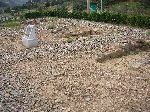
|
Jucknaeri archeological site: An excavation of the site by Chosun
University found Paleolithic, Bronze Age and Three Kingdoms period relics. A
sign at the site describes the differences in the items found in the four
different Paleolithic layers. |
| |

|
"So-tae," wooden birds on poles.
Traditionally these marked the boundaries of a village and were for good luck.
Contemporarily the are used more as decorative art. I saw these in a couple
locations. |
| |
 |
The bus system is very extensive.
A bus seem to find its way to almost every road in the country at least a couple
times a day. Here the bus shelter, shaped like a mushroom, is colorful,
creative and playful. |
| |
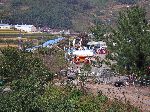
|
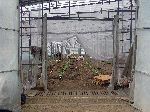 A mix of farmland and green
houses in the valley. Green houses are generally large enough to operate a
small tractor in and are used to produce a lot of vegetables. A mix of farmland and green
houses in the valley. Green houses are generally large enough to operate a
small tractor in and are used to produce a lot of vegetables. |
| |
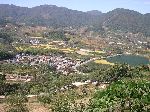
|
More verification that the hills are wooded and
the valley floor is used for agriculture and housing. |
| |
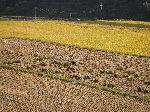
|
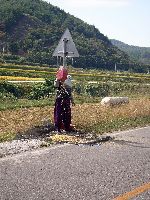 This couple
(left) is working together to stack the straw from
the freshly harvest rice. A woman (right) uses the wind and the side of the road to
clean the chaff out of her beans. This couple
(left) is working together to stack the straw from
the freshly harvest rice. A woman (right) uses the wind and the side of the road to
clean the chaff out of her beans. |
| |
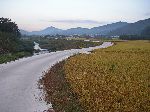
|
Dikes roads and "tractor
roads" are a feature of rural South Korea that are very handy as car-free,
and consequentially much more care-free, bicycle facilities. Suncheon district. |
| |
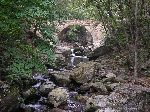
|
One often cross a bridge over a stream
approaching a temple for a symbolic cleansing. When the water level is right
in the stream at Sonamsa, the stone bridge, with its reflection in the pool below, makes a perfect circle. |
| |
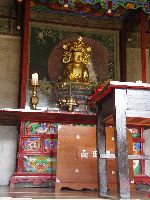 |
Sonamsa (temple) is said to have originated from
the Biro-am hermitage, built in 529 or 542. The name Sonam derives from
the large and flat rock on which two hermits used to play Paduk (Korean chess).
One of the prominent monk who live at Sonamsa was Master Uich'on (1055-1101).
After studying in China, upon his return, his mail goal was to try to reconcile
the differences between the meditation oriented Zen school and the doctrinal
Hwaom school, which had become almost completely alienated from each other.
To this end he revived the Ch'ont'ea school, which believed the study of
Buddhist texts and the pursuit of meditation are complementary and should go
hand in hand. |
| |
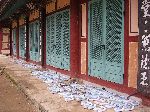 |
In 1985, the temple established T'aekoch'omgrim to
train Buddhist leaders and promote traditional Buddhism of Korea. In this
picture on the right, the shoes of dozen of novices can be seen outside the door
of a pray hall. |
| |
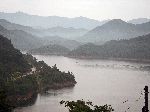
|
The land of the morning clam. Sangsaho Lake. |
| |

|
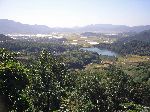 Naganeupseong Folk Village is a walled village that
has been preserved and restored to maintain the heritage of the people.
The 1.4 km perimeter wall was started in the late 1300 to protect the people
from Japanese pirates. Naganeupseong Folk Village is a walled village that
has been preserved and restored to maintain the heritage of the people.
The 1.4 km perimeter wall was started in the late 1300 to protect the people
from Japanese pirates. |
| |
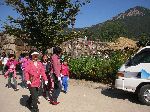 |
The living museum is a very popular
destination for elementary school classes. There were a dozen buses full
of students visiting at the time we toured. |
| |
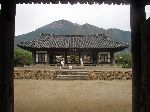
|
This is the government sections, which includes
administrative office buildings and a guest house. The buildings are much
more substantial and the roofs are ceramic tiles. Naganeupseong Folk Village |
| |
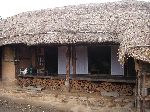
|
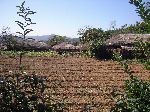 Naganeupseong Folk Village traditional houses had thatched roofs and a number
of rooms with separate entrances. Besides the buildings there are people who
dress in period fashions and demonstrate activities as they were done
traditionally. There is also a site museum with displays, artifacts
and explanations. Naganeupseong Folk Village traditional houses had thatched roofs and a number
of rooms with separate entrances. Besides the buildings there are people who
dress in period fashions and demonstrate activities as they were done
traditionally. There is also a site museum with displays, artifacts
and explanations. |
| |
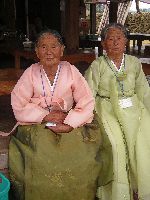
|
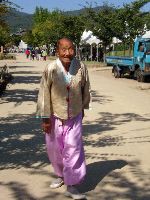 The folk village is a popular destination for
Korean. These two lovely senior women (left) were visiting with their family
and consented to being
photographed in their hanboks, the tradition formal dress of Korea. The
traditional dress for men (right) is also called hanbok. The folk village is a popular destination for
Korean. These two lovely senior women (left) were visiting with their family
and consented to being
photographed in their hanboks, the tradition formal dress of Korea. The
traditional dress for men (right) is also called hanbok. |
| |
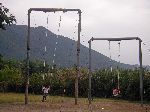
|
Two young girls swing on a couple of super-size
swings. |
| |
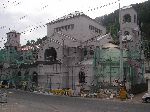
|
While almost every Buddhist temple we past seemed
to have some kind of building, renovation or restoration project underway, this
is the only Christian church I noticed that was an active construction project. |
| |
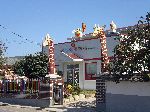 |
Most towns of any size have a day care
/ nursery school / pre-school. The reflects the change in the culture to
two working parents, who are not in close enough proximity to grandparents to
get daily child care. |
| |
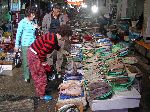
|
Every town of any size seems to have a covered
central market with a wide variety of goods available in large numbers.
Somehow the fish section of the market always seems the most photogenic, or at
least the most visually unusual to the Western eye. Once again, here is a
fish vendor picture to document that I explored Beolgyo market. |
| |
|
|
| |
Gurye

 Wando Wando |
|
    |
 |
|
|
 Please
contact us if you would like to be added to
Ibike's mailing list or have questions, comments, corrections or criticism. (Also, please let us know how you learned about us and
found this site.) Privacy policy. Please
contact us if you would like to be added to
Ibike's mailing list or have questions, comments, corrections or criticism. (Also, please let us know how you learned about us and
found this site.) Privacy policy.
 IBF Homepage
IBF Homepage  Ibike Programs
Ibike Programs
 Ibike Schedule
Ibike Schedule
 Search
Search
"Hosted by
DreamHost - earth friendly web hosting"
Created by David Mozer
Copyright ?1993-2018 Ibike LLC. All rights reserved.
|
 Photo essay: Gurye to Beolgyo
Photo essay: Gurye to Beolgyo



 A mix of farmland and green
houses in the valley. Green houses are generally large enough to operate a
small tractor in and are used to produce a lot of vegetables.
A mix of farmland and green
houses in the valley. Green houses are generally large enough to operate a
small tractor in and are used to produce a lot of vegetables.

 This couple
(left) is working together to stack the straw from
the freshly harvest rice. A woman (right) uses the wind and the side of the road to
clean the chaff out of her beans.
This couple
(left) is working together to stack the straw from
the freshly harvest rice. A woman (right) uses the wind and the side of the road to
clean the chaff out of her beans.





 Naganeupseong Folk Village is a walled village that
has been preserved and restored to maintain the heritage of the people.
The 1.4 km perimeter wall was started in the late 1300 to protect the people
from Japanese pirates.
Naganeupseong Folk Village is a walled village that
has been preserved and restored to maintain the heritage of the people.
The 1.4 km perimeter wall was started in the late 1300 to protect the people
from Japanese pirates.


 Naganeupseong Folk Village traditional houses had thatched roofs and a number
of rooms with separate entrances. Besides the buildings there are people who
dress in period fashions and demonstrate activities as they were done
traditionally. There is also a site museum with displays, artifacts
and explanations.
Naganeupseong Folk Village traditional houses had thatched roofs and a number
of rooms with separate entrances. Besides the buildings there are people who
dress in period fashions and demonstrate activities as they were done
traditionally. There is also a site museum with displays, artifacts
and explanations.
 The folk village is a popular destination for
Korean. These two lovely senior women (left) were visiting with their family
and consented to being
photographed in their hanboks, the tradition formal dress of Korea. The
traditional dress for men (right) is also called hanbok.
The folk village is a popular destination for
Korean. These two lovely senior women (left) were visiting with their family
and consented to being
photographed in their hanboks, the tradition formal dress of Korea. The
traditional dress for men (right) is also called hanbok.



 Please
contact us if you would like to be added to
Ibike's mailing list or have questions, comments, corrections or criticism. (Also, please let us know how you learned about us and
found this site.) Privacy policy.
Please
contact us if you would like to be added to
Ibike's mailing list or have questions, comments, corrections or criticism. (Also, please let us know how you learned about us and
found this site.) Privacy policy.![]() IBF Homepage
IBF Homepage ![]() Ibike Programs
Ibike Programs
![]() Ibike Schedule
Ibike Schedule
![]() Search
Search


